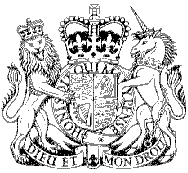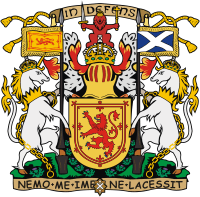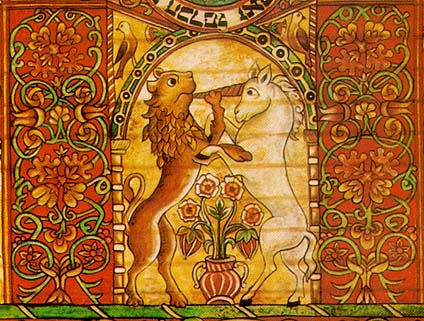Lion and Unicorn

Biblical Locations
of the Lost Ten Tribes
Scriptural Proof
The Joseph Aspect
by Yair Davidiy
Biblical Evidence: The Joseph Aspect
The Lion and Unicorn
The Lion and Unicorn were representative of Israel
in its aspect of power in the End Times. The lion and unicorn are on the coat
of arms officially symbolizing Britain.
Bilaam the heathen prophet foresaw that in the End Times the descendants
of Israel would be very powerful. He likened them to a lion and a raem
or unicorn.
The Coat of Arms of Britain

The Coat of Arms of Scotland

<<GOD BROUGHT THEM OUT OF EGYPT;
HE HATH AS IT WERE THE STRENGTH OF AN UNICORN.
<<SURELY THERE IS NO ENCHANTMENT AGAINST JACOB, NEITHER IS THERE
ANY DIVINATION AGAINST ISRAEL: ACCORDING TO THIS TIME IT SHALL BE SAID OF
JACOB AND OF ISRAEL, WHAT HATH GOD WROUGHT!
<<BEHOLD, THE PEOPLE SHALL RISE UP AS A GREAT LION, AND LIFT UP HIMSELF
AS A YOUNG LION: HE SHALL NOT LIE DOWN UNTIL HE EAT OF THE PREY, AND DRINK
THE BLOOD OF THE SLAIN>> [Numbers 23:22-24].
The symbols of Scotland had two unicorns and that
of the United Kingdom of Great Britain had a lion and a unicorn. The Midrash
(Numbers Rabah) says that the raem (unicorn) was the symbol of MANASSEH. In
our passage Israel is likened to a unicorn. Only in Britain does the unicorn
appear as a national symbol. On the other hand the
unicorn came to Britain from Scotland which is still represented by two
unicorns. More than 80% of the founding settlers of the USA came from Scotland
and related areas in the North and West of Britain.
How Many Horns Did the Unicorn Have?
<<HIS HORNS ARE LIKE THE HORNS OF UNICORNS>> [Deuteronomy 33:17].
This phrase in the Hebrew says, Karnei [the Horns of] Raem [a unicorn] Karnov
[are his horns]. The expression in the Hebrew can in effect be understood
to say that the raem (unicorn) has more than one horn. Rabbinical Commentators
however (and the King James Translation after them) chose to interpret it
as consistent with the Raem having only one horn. In this their opinion was
consistent with that of the major Rabbinical Commentators. There is in fact
a Biblical verse that could justify this view:
<<HE HATH AS IT WERE THE STRENGTH [Hebrew: TOYAFOTH] OF AN UNICORN>>
[Numbers 23:22].
The word translated above from the Hebrew as strength is TOYAFOTH and literally
means that which he is exalted by (lifted up) and appears to be referring
to the horns. This word is spelt one way and traditionally pronounced another.
It is spelt in the singular and pronounced in the plural. The expression of
strength (Toyafoth), meaning the horns which are normally plural, in this
case have become ONE [TOYAFATH: in the singular instead of TOYAFOTH
in the plural]. Perhaps it is an animal that in some cases has one horn and
in other cases has two?
The Classical Opinion
Rabbi David Kimchi (Safer HaShorashim, RAEM): <<HIS HORNS ARE LIKE
THE HORNS OF UNICORNS (Deuteronomy 33:17). It is intended to mean that his
horns are like the horns of (several) unicorns for the Raem has only one horn.
[Psalms 29:6] HE MAKETH THEM ALSO TO SKIP LIKE A CALF; LEBANON AND SIRION
LIKE A YOUNG UNICORN. [Psalms 22:21] SAVE ME FROM THE LION'S MOUTH:
FOR THOU HAST HEARD ME FROM THE HORNS OF THE UNICORNS, i.e. A wild beast
of the wilderness, extremely strong.>>
The Greek Translation of the Bible (Septuagent) translates Raem (Numbers
23:22) as monoceros i.e. one-horned. Saadia, Yehudah HaLevi, and Ibn
Ezra also considered the "Raem" to be a unicorn (see Kaplan in the "Living
Torah"), as did Menasseh ben Israel.
Did the Unicorn Exist? In our magazine Brit-Am Truth no.7 there is
an article discussing this question in depth. There were animals with one
horn such as the narwal (a small whale with a long horn);
the "sakea" which was a kind of
goat like deer depicted by the Assyrians with one horn. In some opinions the sakea was a mythical
animal (THE ARAB FRINGE. AN ENQUIRY CONCERNING Mutsri, KUSH, MELUHHA AND MAGAN
by Michael Banyai
http://www.abara2.de/chronologie/fringe.php);
The Prehistoric Elasmotherium: "This was a gigantic rhinoceros the size of
an elephant, with a horn that may have measured up to six feet long.
Unlike the contemporary rhinoceros, the horn of the elasmotherium was situated
on its forehead rather than on its nose." (Mysterious Creatures. Intriguing
Torah Enigmas of Natural and Unnatural History, Nosson Slifkin, Israel, 2003
p.62). This animal was reportedly extinct long before the age of man, but
who knows?
The auroch which was a gigantic wild bull of immense strength and only
recently extinct has also been suggested as representing the "raem" and in Akkadian (the language of Ancient Assyria) the word "rimu" appears to mean an auroth.
Whatever the "raem" originally
was it became identified with the unicorn and together with the
lion these two were used as symbols of Britain.
Detail from synagogue ceiling, in Hodorov (in Poland?),
17th-c. reconstruction.
Picture depicts a lion and unicorn.
The lion is kissing the horn of the unicorn -perhaps indicating
the reunification of Judah and Joseph?

 Previous
Previous Previous
Previous



 Previous
Previous